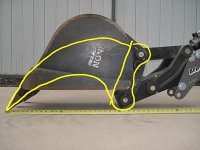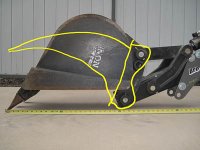jim_wilson
Veteran Member
- Joined
- Jun 13, 2004
- Messages
- 1,781
- Location
- Northeast MA
- Tractor
- Kubota B3200 w/ BH77 & 12", 18" & 24" buckets, Kubota B50 SSQA w/ 54" & 60" buckets, LandPride FDR1660, Artillian Fork frame, Extreme 3pt rake, Concrete Mixer, MyTractorTools grapple adapter
Too bad you don't have a Woods BH or I could have loaned you my ripper to try out!
After three seasons or so I am still very happy with my ripper. It does what it was designed to do. My only complaint is not about the ripper but rather the hassle factor in changing out the bucket/thumb. Last season I just didn't mount the thumb to make it easier to line things up. I've talked to MIE about having them build a quick attach mount but haven't gotten around to doing that yet. I am also in perpetual search mode for a taped pin that could be used to force the holes into alignment. If anyone finds a source please post!
I've wanted a quick attach for the buckets on my BH77 since before I even got the thing. I had a BX23 before this - and I had a 24" bucket for it that was extremely handy for certain jobs - but the hassle of swapping it over made me avoid using it if I thought I could get away with it. When I bought the BH77 I did a decent amount of research on what the available alternatives were out there - and even went as far as buying the bucket quick attach for a B26 to try and see if it might be made to work (the BT820 hoe and the BH77 hoe are VERY similar in size) - but I haven't made much progress on it. I have found out recently that the old BT751 hoe from the B21 and the BH77 hoe - use the same buckets. And I have seen a few B21's with quick attaches on their backhoes. Just recently I saw an Ebay auction with a BT751 with a quick attach from CE Attachments - so it's likely there's somebody out there that either already makes one - or could make one. I'd love to design and build my own - but I'm sort of behind the 8-ball on that one. Too many other projects stacked up - a shop in dis-array - and I need a new welder. So for the short run anyway - I'm just going to have to suck it up and manually mount the thing once I get it.


